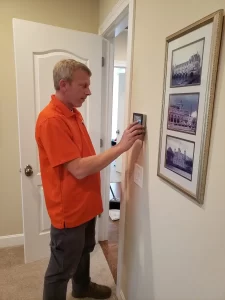As we cozy up in our homes during the chilly months, we often rely on our heating systems to keep us warm and comfortable. For many households,
heat pumps are the primary source of heating and cooling. But have you ever noticed your system kicking into auxiliary heat mode and wondered why?
When you see “aux” heat on your thermostat that means your system has kicked into auxiliary heat mode. Auxiliary heat, also known as backup heat, is an additional heating source used by heat pumps when the primary heat pump system alone isn’t sufficient to maintain the desired indoor temperature. Many homeowners may wonder if it’s a bad thing to be running in aux heat mode. Let’s delve into why auxiliary heat might activate and explore some common scenarios.
What is Auxiliary Heat?
Before diving into the reasons for its activation, let’s understand how auxiliary heat functions within a heat pump system. Heat pumps work by extracting heat from the outdoor air and transferring it indoors to warm your home during the colder months. However, as outdoor temperatures drop, the efficiency of heat pumps decreases.
When the temperature falls below a certain point, usually around 35 degrees Fahrenheit, or when there’s a significant temperature difference between the set indoor temperature and the current temperature indoors, the heat pump alone may struggle to meet the heating demand. This is where auxiliary heat comes into play.
Why Auxiliary Heat Turns On
Below 35 Degrees
One of the most common triggers for auxiliary heat activation is when the outdoor temperature drops below the balance point, typically around 35 degrees Fahrenheit. At this point, the heat pump’s efficiency decreases, and auxiliary heat is called upon to provide supplemental heating to maintain indoor comfort.
Temperature Differential
If you’ve set your thermostat to raise the indoor temperature by 3 degrees or more compared to the current temperature, the heat pump may engage auxiliary heat to quickly bridge the gap and reach the desired temperature.
Defrost Mode
During colder weather, frost can accumulate on the outdoor unit’s coils. To remove this frost and maintain efficiency, the heat pump enters defrost mode. While in defrost mode, the system temporarily switches to cooling mode, and auxiliary heat kicks in to maintain indoor warmth until the defrost cycle is complete.
Faulty Components
Auxiliary heat may also activate due to issues with components within the heat pump system. A faulty fan motor, a malfunctioning compressor, or a defective defrost control board can all disrupt the normal operation of the heat pump, leading to the activation of auxiliary heat as a safety measure.
Auxiliary Heat vs Emergency Heat
Understanding the distinction between a heat pump’s auxiliary heat and emergency heat is crucial
Auxiliary Heat
Supplemental Heating
Auxiliary heat, also known as backup heat, is a supplementary heating source integrated into heat pump systems. Its primary function is to provide additional heating support when the heat pump alone cannot adequately meet the heating demand.
Activated Automatically
Auxiliary heat is programmed to activate automatically by the thermostat or the heat pump’s control board when certain conditions are met.
Efficient Operation
While auxiliary heat may consume more energy than the heat pump alone, it’s designed to operate efficiently and effectively supplement the heating process without causing excessive energy usage or significantly impacting utility bills.
Overall, running in auxiliary heat from time to time is expected with a heat pump. As long as it is not running outside of the situations discussed earlier then it is acceptable to continue to run in aux heat as long as it’s needed.
Emergency Heat
Last Resort Heating
Emergency heat, sometimes referred to as “auxiliary emergency heat” or simply “EM heat,” serves as a last resort heating option when the heat pump system is unable to function properly or is temporarily disabled. It’s typically activated manually by the homeowner via the thermostat in situations where the heat pump is malfunctioning or requires maintenance.
Electric Resistance Heating
Unlike auxiliary heat, which typically consists of a secondary heat source like electric resistance coils or a furnace, emergency heat exclusively relies on electric resistance heating elements. These elements generate heat independently of the heat pump system and are often less energy-efficient than the primary heat pump operation.
Higher Energy Consumption
Emergency heat should only be used sparingly and in genuine emergency situations, as it tends to consume more energy than the heat pump system. Prolonged or unnecessary use of emergency heat can result in significantly higher utility bills.
How Do I Stop Auxiliary Heat From Coming On?
The biggest tip to stop your heat pump from using auxiliary heat mode is to try to prevent your home’s temperature from dropping rapidly. You can do this by adding insulation or closing doors to rooms that you’re not currently using. Annual heat pump maintenance can also aid in efficient operation.
Contact Quality Comfort Home Services for Heat Pump Repair in Cincinnati, OH
If your heat pump is stuck in auxiliary heat or you are in need of other heat pump service, don’t hesitate to call Quality Comfort at 513-620-4822 or book service online.


